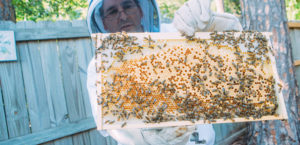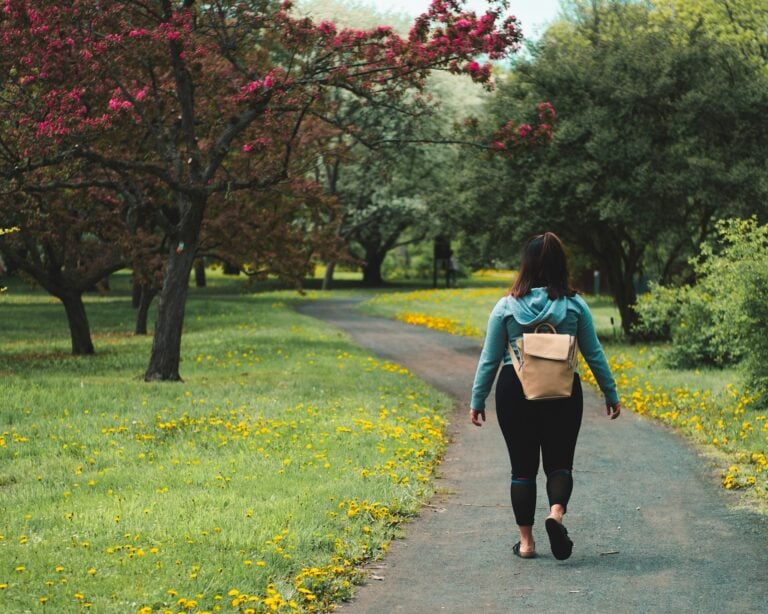Horticultural Hive-Mind: A Gardener’s Guide To Protecting The Bees
 (www.glorybee.com) When you see a small, striped, stinging creature making its way from flower to flower, you might be inclined to cry out in fear. If you’re allergic or entomophobic, it’s understandable why you’d react this way. But even if you’re not particularly fond of the humble honey bee, it’s important to realize just how important these insects actually are to our own survival.
(www.glorybee.com) When you see a small, striped, stinging creature making its way from flower to flower, you might be inclined to cry out in fear. If you’re allergic or entomophobic, it’s understandable why you’d react this way. But even if you’re not particularly fond of the humble honey bee, it’s important to realize just how important these insects actually are to our own survival.
While a productive beehive can produce and store nearly two pounds of honey in just a single day, these little guys represent so much more than just the sweet stuff. In fact, you can thank bees for one out of every three bites of food you consume. With bee populations becoming more scarce, the implications for us humans are actually astronomical. By taking action to save the bees now, we’re actually making a pledge to save ourselves.
But taking on that responsibility can seem daunting. Where can we even begin? In many cases, the best place to start might be right in your own backyard. Whether you’ve got a naturally green thumb or you simply want to make good use of your garden, there are plenty of ways to help your local bees thrive without ever leaving your home.
What Would Happen If Bees Ceased To Exist?
This might sound like a far-fetched dystopian novel, but it’s actually a feasible and unfortunate possibility. All across the world, bees are disappearing. There are several causes for this, including global warming, pesticide use, and habitat loss. Together, these factors have contributed to what’s known as Colony Collapse Disorder. Although one single colony can house an estimated 60,000 bees, U.S. beekeepers now estimate that nearly one-third of all honeybee colonies across the nation have vanished.
 “So what?” some people might say to themselves. “That means there are fewer bees to bother me during the summertime!” But the reality is that the rapidly dwindling bee population spells disaster for humankind.
“So what?” some people might say to themselves. “That means there are fewer bees to bother me during the summertime!” But the reality is that the rapidly dwindling bee population spells disaster for humankind.
Don’t bee-lieve us? More than one-third of all crop production in the United States requires pollination. That third encompasses upwards of 90 different types of crops, including all kinds of fruits, vegetables, and nuts. Bees are our nation’s primary pollinators, responsible for increasing fruit and vegetable harvest yields by up to 71% and adding at least $15 billion a year to our economy.

But what does all of that mean for you? Among other things, it means that without bees, you would never be able to enjoy many of your absolute favorite foods. Consider the following delectables that will no longer be readily available without these important pollinators.
.
.
IF WE LOSE THE BEES, WE’LL ALSO LOSE…
- Apples

- Oranges
- Lemons
- Limes
- Almonds
- Avocadoes
- Carrots
- Cucumbers and pickles
- Blueberries
- Cranberries
- Cherries
- Raspberries
- Onions
- Broccoli
- Cantaloupe
- Cashews
- Cauliflower
- Watermelon
- Brussel sprouts
- Pumpkins
- Zucchini
- Coffee
- Mangos
- Passionfruit
- Apricots
- Plums
- Peaches
- Nectarines
- Pears
…And so much more. While not all of these crops are readily grown throughout the United States, the national bee population crisis mirrors similar problems the world over and could indicate a global agricultural decline. That means that if things continue to get worse for American bees, we’re in big trouble.

What Can Gardeners Do To Help?
Farming practices and protections for bees must be improved on a national scale, of course, but that may leave you feeling relatively powerless to help on your own. Don’t despair. The truth is that you can make a huge impact by incorporating certain elements and practices into your own gardening endeavors. You can easily make your backyard both beautiful and buzzy by following the tips below.
Limit your use of insecticides
As a general rule, refrain from using pesticides (including insecticides), herbicides, and other chemicals in your garden or even on your lawn. These chemicals are typically toxic to beesand can even be harmful to your plants in the long run. Even low doses of these chemicals can kill bees who are just trying to forage for food. And when pesticides are inadvertently brought back to the colony, these toxins can infect all the other bees and even the honey. Take note that even “biodegradable” pesticides can harm both bees and humans. Instead, opt for natural pesticides like ladybugs and praying mantises, neem oil, vinegar, epsom salt, or a homemade spray containing pepper, onion, or garlic.

Don’t be too quick to weed or cut
If you’re an avid gardener, you might hate the sight of weeds infiltrating your lawn or garden — even the flowering ones. But before you get rid of those dandelions and clovers, consider that these alleged undesirables can provide lots of deliciousness for your buzzing visitors. By keeping them right where they are, you’ll be helping your bee friends thrive. The same goes for flowers and vegetables you’ve actually taken the time to plant; if you harvest or deadhead these but leave them intact until all the flowers are completely gone, you’ll be able to support pollinators during their time of need (particularly when other options aren’t readily available).
Choose plants that bees love
Bees pollinate a wide variety of plants and may visit up to 15,000 flowers in a day’s time. But there are certain ones they really adore. Native wildflowers are a very popular choice, as they’ll thrive in your climate and will be sure to attract local bees. Flowering herbs like lavender, thyme, sage, rosemary, and mint are also excellent options (plus, they’ll make your garden smell incredible and will make sure your meals are flavorful!). Sunflowers, bachelor’s buttons, black-eyed susans, bee balm, goldenrod, coneflower, daisies, calendula, and marigolds are all great, too. Don’t forget about vegetable gardens and fruit trees!

Keep in mind that single flower tops are easier for bees to access than double flower tops. You may also want to keep certain colors of plants together to make it easier for bees to find their favorites. Fun fact: blues and purples are most likely to attract bees! When you’re planning out your garden, remember to select an array of blooms that will flower from early spring until late fall. This will help to provide the most possible pollen throughout these seasons, instead of having a “feast or famine” situation on your hands. Not only will that keep the bees well-fed, but it will make certain your garden is always in bloom!
Create a water source
Bees, like all other animals, need water to survive. You can help them out by creating a shallow water source where they can drink. Fill a relatively flat container with water and be sure to include some pebbles and twigs for the bees to rest on while they hydrate. You can also use a bird bath with sloped walls. Be sure to freshen this water on a daily basis to let your visitors know they can return to this spot whenever they need a breather and some H2O.
Provide a shelter and habitat
The idea of creating a makeshift nest for wayward bees might not exactly appeal to you; after all, the last thing you want is a bunch of angry, stinging insects coming after you. But bees only sting when they perceive a threat to their environment. By creating a welcoming home for them, they’ll be very happy to spend their days foraging for food. Lone bees will often like pieces of untreated wood, uncultivated soil, wilder hedges, or muddy spots. This might not make for the prettiest site, but dedicating a tucked away corner of your garden to this cause can make these little guys very happy. If you don’t want to go to those lengths, you can at least provide some shelter from the harsher elements by being creative with the placement of your potted plants and little spots in which bees can take temporary refuge.

Buy local honey
This is something just about anyone can do, even if they don’t like to garden. Beekeeping is an amazing endeavor, but the truth is that not everyone is cut out for it. If you try to take on this responsibility without the proper knowledge, you could end up doing more harm than good. That’s why it’s important to support your local beekeepers to ensure their efforts aren’t in vain. And while it hasn’t been totally proven, there is evidence to suggest that local honey can be the best thing for your allergies!
Know how to aid a tired bee
Have you ever seen a bee who seems to be struggling to fly? You might assume that it’s injured or worse, but this sweet bee might actually just be worn out. It’s usually pretty easy to revive them and get the buzz back in their wings. Just mix together two tablespoons of white, granulated sugar (no artificial sweeteners or honey from your cupboard!) and one tablespoon of water, then place on a plate or a spoon and bring the bee to drink. You can even put this mixture in a small, shallow container and leave it somewhere in your garden to keep your friends from getting too tired on-the-go. If you find a wet bee out in the rain, bring to a place where it can get dry; if you see a bee lying motionless on a flower, keep in mind that it may simply be resting, so don’t be too quick to try to move it and feed it.

Make your hometown a Bee City
If you want to make even more of an impact outside your garden, you can become a champion for the bees on a city level. Organizations like Bee City USA support the creation of sustainable bee habitats and endorse a set of commitments for townships that want to take steps to protect these populations. Currently, there are 70 certified Bee Cities throughout the country that have pledged to make a difference in their communities. For those who are already doing everything they can on the homefront but who want to precipitate more change, this can be a viable option along with becoming more involved with bee conservation organizations on a global scale.
WHY YOU SHOULD EMBRACE YOUR FLOWER POWER
If you aren’t a fan of insects or yearn for a neat, precise garden space, you might not relish the thought of inviting bees to the botanical buffet. But remember: our future depends on these so-called pests. By making room for them in our gardens and appealing to their taste buds, we can help preserve this declining population and allow them to make a buzzworthy comeback. Ultimately, that’s to everyone’s benefit, as our nation needs these bees to stay alive ourselves. Making relatively small adjustments in your garden and in your lifestyle could make all the difference in their population and in our planet as a whole.
Content provide by www.glorybee.com


